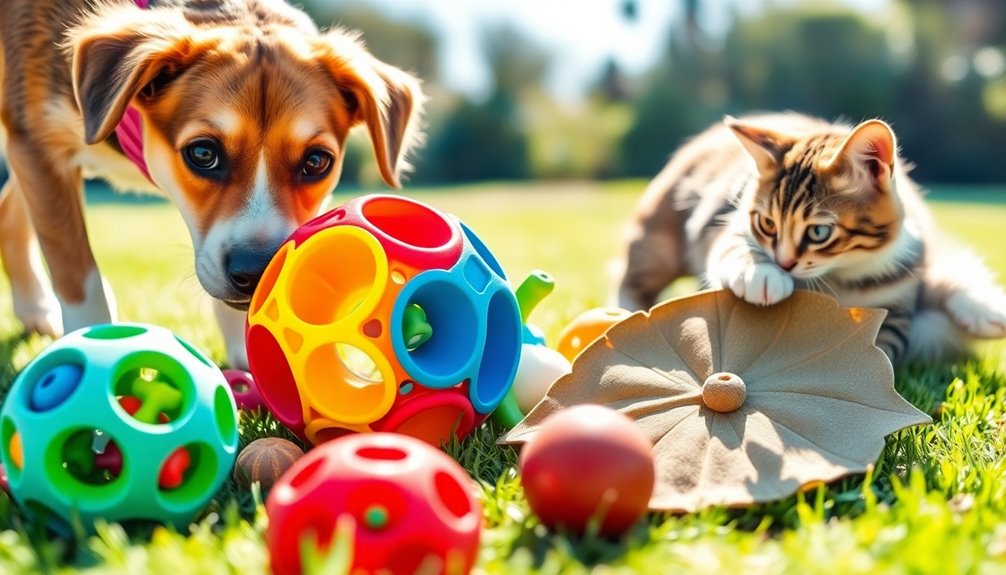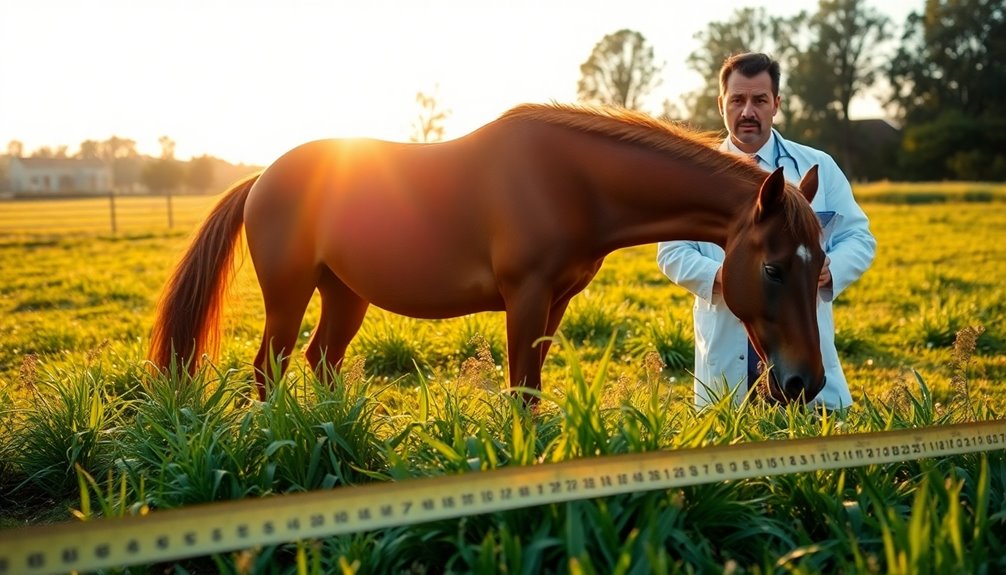Foraging toys are fun, interactive feeding tools that tap into your pet's natural instincts. They encourage mental and physical engagement by mimicking hunting behaviors, like sniffing and chasing. These toys can reduce boredom and promote healthier eating habits as pets "hunt" for their food. They're available in various styles, from puzzle feeders to snuffle mats, catering to different skill levels and preferences. Regular use not only enhances your pet's cognitive function but also lowers anxiety. Your furry friend will adore the challenge and excitement these toys bring, and there's much more to discover about their benefits and types!
Key Takeaways
- Foraging toys stimulate pets' natural instincts, encouraging behaviors like sniffing and chasing while providing mental and physical engagement.
- These interactive puzzle feeders promote healthier eating habits by allowing pets to "hunt" for their meals, slowing down their eating.
- Various types of foraging toys cater to different skill levels and instincts, ensuring pets remain engaged and challenged during playtime.
- Regular use of foraging toys enhances cognitive function, reduces anxiety, and fosters healthier habits, contributing to overall pet well-being.
- Pet owners report increased curiosity and enthusiasm from their pets, with playtime extending and satisfaction ratings averaging 4.5 out of 5 stars.
Foraging Toys Overview and Benefits
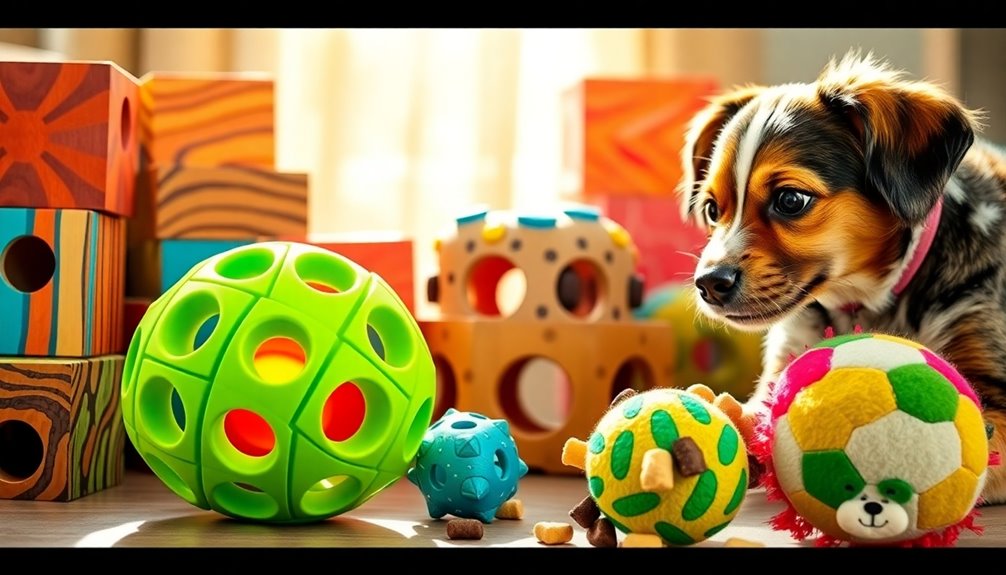
Foraging toys are a great way to tap into your pet's natural instincts while providing essential mental and physical stimulation. These engaging tools mimic natural hunting behaviors, encouraging activities like sniffing, chasing, and capturing, which keeps pets mentally sharp and physically active.
By incorporating foraging toys into your pet's routine, you can considerably reduce boredom and promote species-specific activities that enhance their overall enjoyment.
Using puzzle feeders as a replacement for traditional food bowls can be particularly beneficial. When you allow your pet to "hunt" for their meals, you not only satisfy their foraging instincts but also foster healthier eating habits. This approach is especially effective when you're feeding a scheduled meal, as slightly hungry pets are more motivated to engage with these toys and enjoy the rewards of their efforts.
Regular interaction with foraging toys can improve cognitive function in senior pets, support oral behaviors in puppies and kittens, and maintain cognitive health in adult dogs and cats. Additionally, similar to how educational toys enhance children's learning through interactive play, foraging toys can stimulate pets' minds and encourage problem-solving skills.
Selecting and Using Foraging Toys
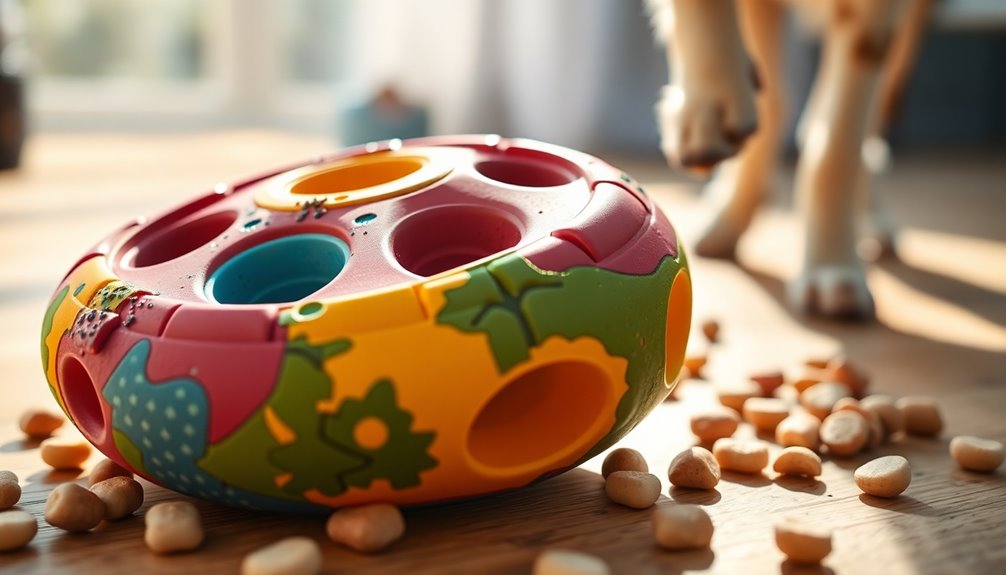
Choosing the right foraging toys for your pet can make a significant difference in their engagement and enjoyment. Start by confirming the toys are size-appropriate and durable to prevent any swallowing hazards and withstand active play.
When selecting foraging toys, consider the difficulty of the task. Choose toys that match your pet's skill level; fewer dispensing holes and compartments can increase the challenge, keeping them interested.
As your pet interacts with these feeding devices, monitor their initial engagement. If they seem disinterested, you may need to adjust the difficulty to spark their curiosity. For effective motivation, use treats that align with your pet's preferences. Offering toys when they're slightly hungry can also enhance their engagement.
Don't forget to regularly clean and inspect foraging toys for wear and tear. This not only confirms safety but also maintains hygiene.
Replace any toys that show signs of damage, as your pet's safety should always be a priority. By carefully selecting and using foraging toys, you can provide your pets with a stimulating and enjoyable experience that promotes both mental and physical well-being.
Engagement Levels and Challenges
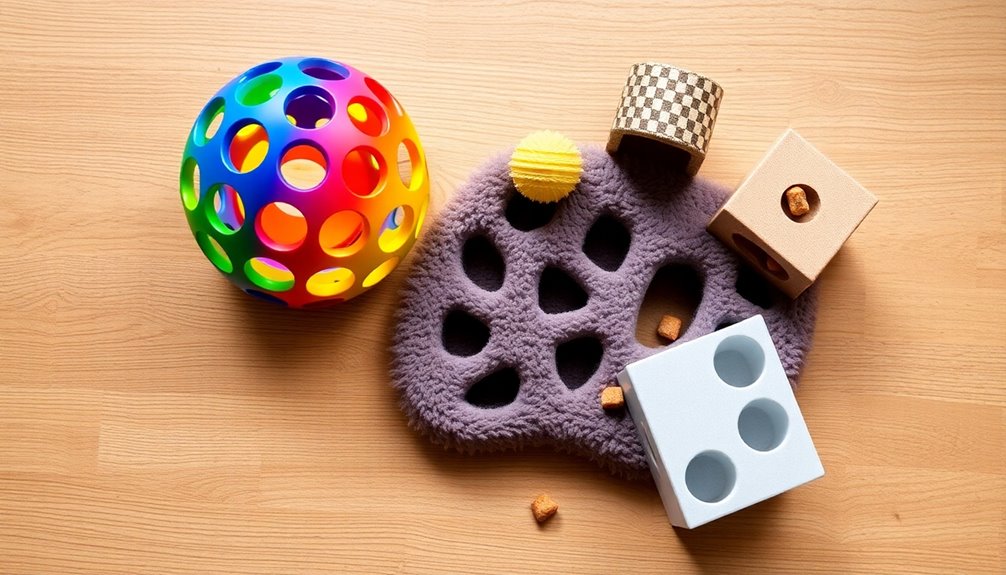
Engagement with foraging toys varies among pets, and understanding their different levels of challenges can help you tailor the experience.
Foraging toys come in various difficulty levels, which you can adjust by changing treat sizes, the number of dispensing holes, and the complexity involved in accessing the treats. If your pet struggles with a puzzle toy, consider reducing the difficulty by opting for toys with more compartments or larger treats.
Pets that initially show disinterest may benefit from this reduced difficulty level, sparking their interest and encouraging them to engage.
It's also helpful to present these toys when your pet is slightly hungry, as this boosts their motivation to play.
Regularly using foraging toys not only entertains but also promotes mental stimulation, greatly contributing to your pet's cognitive health.
Meal Replacement Strategies
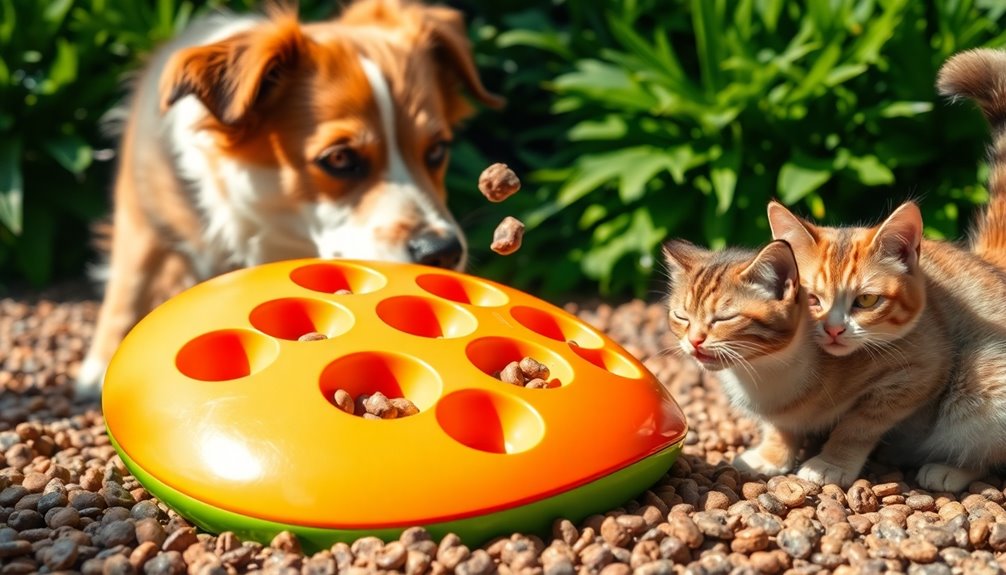
By replacing traditional food bowls with foraging toys, you can enhance your pet's mealtime experience while tapping into their natural instincts.
To effectively use these feeding toys as meal replacements, you must monitor your pet's daily rations to prevent overfeeding. Start by offering a portion of their kibble or treats in a foraging toy and the remainder in a bowl. This allows you to observe which method your pet prefers for feeding.
If your pet consistently chooses the foraging toy, it indicates a desire for more interactive and stimulating feeding experiences. This change not only keeps mealtime exciting but can also lead to improved overall satisfaction and health.
When adapting to foraging toys, begin with simpler tasks to build your pet's confidence and gradually increase complexity to maintain their engagement. Additionally, consider regular grooming to reduce shedding, as this can enhance the overall mealtime environment for both you and your pet.
Cleaning and Safety Considerations
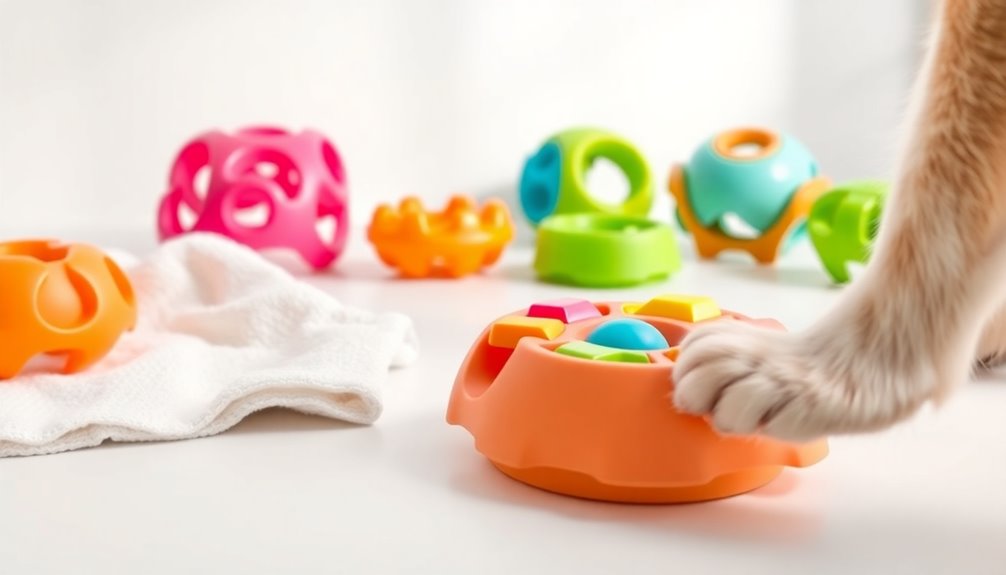
Guaranteeing your pet's foraging toys are clean and safe is essential for their health and happiness. Proper cleaning and hygiene practices not only keep your furry friend safe but also enhance their play experience.
Here are three key considerations:
- Regular Cleaning: Clean and dry your foraging toys after each use to maintain hygiene and prevent bacteria buildup. Hollow toys can be easily cleaned with a bottle cleaner and dish soap. Many are safe for the dishwasher, making cleanup a breeze.
- Inspect for Damage: Regularly check your foraging toys for wear and tear. If you notice any signs of damage, replace them immediately to prevent choking hazards. Safety should always be your top priority.
- Material Matters: Choose durable, non-toxic materials for foraging toys. This guarantees they can withstand your pet's playful antics without breaking into small, hazardous pieces. Additionally, selecting toys made from high-quality materials can contribute to your pet's overall health and well-being.
Popular Foraging Toy Types

After taking the necessary steps to keep your pet's foraging toys clean and safe, it's time to explore the exciting variety of foraging toy types available.
Foraging toys come in several engaging forms that cater to your pet's natural instincts. Simple rubber toys often feature treat pockets, encouraging pets to chew and sniff, making them perfect for teething puppies or heavy chewers.
If you want to challenge your furry friend further, consider interactive puzzle feeders. These toys require your pet to manipulate different parts to access rewards, promoting problem-solving skills and mental engagement.
Snuffle mats, like the AWOOF Snuffle Mat, are another fantastic option. They provide multiple layers and compartments for hiding food, effectively slowing down eating while enhancing the interactive feeding experience.
Plus, multi-compartment feeders add an extra layer of challenge, prompting pets to use various techniques to uncover their treats.
DIY Foraging Toys Ideas
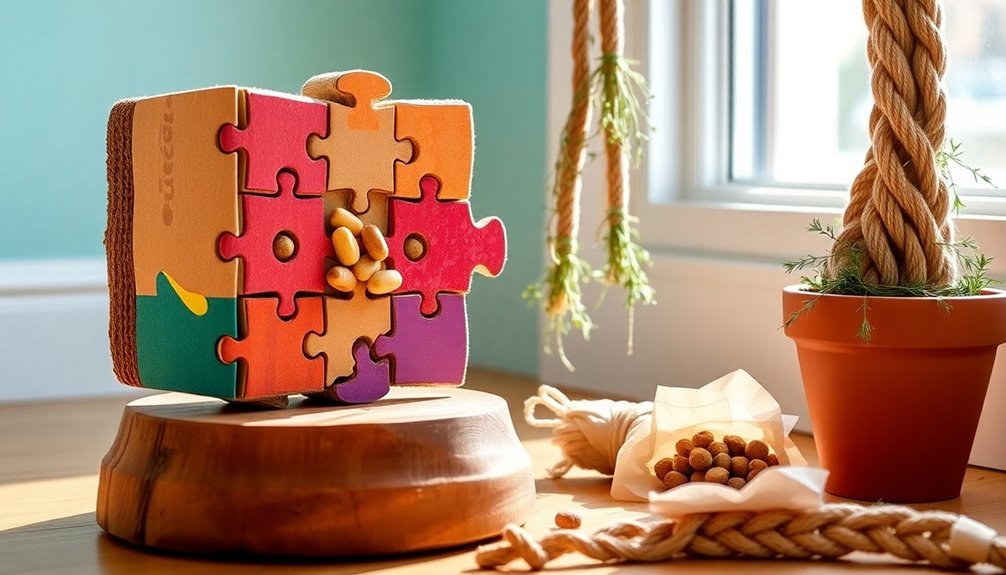
Creating DIY foraging toys is a fun and budget-friendly way to keep your pets entertained and mentally stimulated. You can easily craft engaging toys using everyday household items. Here are three simple ideas to get you started:
- Muffin Tin Puzzle: Place treats in a muffin tin and cover each treat with a tennis ball. Your dog will have a blast figuring out how to remove the balls to access their tasty rewards. This type of engagement can promote natural foraging behavior, reducing boredom and enhancing your pet's happiness. Additionally, engaging in such activities can support a partner through shared experiences of pet care. Moreover, using toys that promote fine motor skills can further enhance your pet's ability to interact with their environment.
- Suspended Treats for Cats: For your feline friend, fill paper cups with wet food and suspend them in crumpled paper. This creates an exciting challenge that taps into their natural hunting instincts. Providing such enrichment can also improve social interaction and reduce anxiety in your pets. Creating a stimulating environment is crucial for their overall well-being.
- Ping Pong Ball Cupcake Toy: Use a metal cupcake pan and hide treats beneath ping pong balls. Your pet will enjoy rolling the balls around to uncover their snacks, making feeding time a playful adventure.
Always supervise your pets while they play with these DIY foraging toys to guarantee their safety and prevent any accidental ingestion of small parts. Additionally, incorporating sensory learning toys can enhance your pets' engagement during playtime.
User Experiences and Feedback

Many pet owners find foraging toys not only engaging but also a lot of fun for their furry friends.
While most pets thrive on the challenge these toys present, some users have raised concerns about their durability and longevity.
It's essential to weigh the joy these toys bring against any potential wear and tear you might encounter.
Engaging and Fun
While some pet owners initially hesitate to invest in foraging toys, they quickly discover the engaging and fun experiences these toys provide.
Here's what you can expect:
- Increased Interest: Many pets show heightened curiosity and enthusiasm as they tackle the challenges of foraging toys.
- Extended Meal Times: Instead of gulping down meals in under a minute, your dog could take 10-15 minutes to enjoy their food, making mealtime more exciting.
- Mental Stimulation: These interactive tools are designed to engage your pets mentally and physically, promoting natural foraging behaviors that help reduce boredom.
User feedback often reveals high satisfaction, with ratings averaging 4.5 out of 5 stars.
Pet owners appreciate how foraging toys not only keep their pets entertained but also prevent destructive habits by providing a mentally stimulating outlet.
Your furry friend will love the challenge of figuring out how to get their food, and you'll enjoy watching them engage with their new toy.
Plus, these toys can transform mealtime into a playful experience, ensuring your pet stays active and entertained.
Why wait? Immerse yourself in the world of foraging toys and enhance your pet's playtime!
Durability and Longevity
When it comes to foraging toys, durability and longevity are top concerns for pet owners. Many users report that while their pets quickly learn to engage with these toys, some parts may need re-gluing shortly after purchase. Your pet's chewing habits can greatly impact the longevity of the toy, so it's essential to take into account what materials are used.
For instance, toys made from thick materials, like the AWOOF Snuffle Mat, often stand up better against active dogs who love to chew and dig.
User feedback suggests that regular supervision during playtime can help prevent damage and guarantee the toy stays in good condition. By keeping an eye on your furry friend, you can address any wear and tear before it becomes an issue.
Many owners express satisfaction with the overall construction of foraging toys, especially when they actively maintain them. To maximize the durability and longevity of these playful puzzle tools, take the time to inspect them regularly.
Impact on Pet Behavior and Health
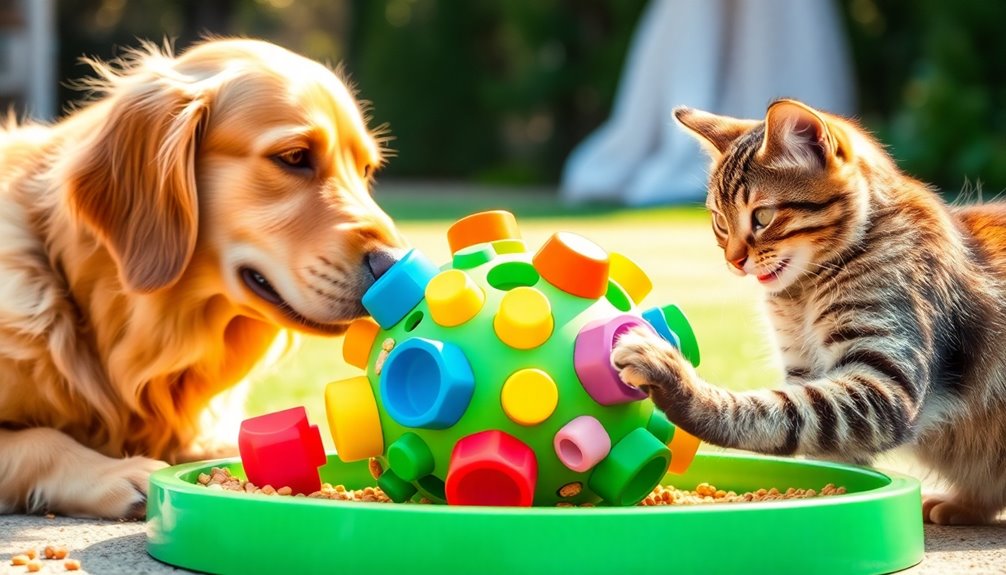
Using foraging toys can markedly enhance your pet's mental stimulation, keeping their minds engaged and active.
You'll notice improved behavior as they channel their energy into productive activities rather than destructive ones.
Plus, these toys help foster healthier habits, leading to happier and more balanced pets.
Mental Stimulation Benefits
Foraging toys provide a dynamic way to boost your pet's mental stimulation by tapping into their instinctual hunting behaviors. These engaging tools not only entertain but also foster cognitive growth, making them an essential addition to your pet care routine. Additionally, educational toys can significantly enhance cognitive development in young children, similar to the benefits of foraging toys for pets. Incorporating risk management strategies into your pet's playtime can also further enhance their overall engagement. Studies show that pet therapy can also enhance emotional well-being, which complements the cognitive benefits of foraging toys.
Here are three key benefits:
- Enhanced Cognitive Function: Regular interaction with foraging toys can improve your pet's memory and problem-solving skills, especially in senior pets, keeping their minds sharp. Additionally, early socialization is crucial for developing well-adjusted adult dogs.
- Reduced Anxiety and Stress: Foraging toys serve as a stimulating distraction, helping to alleviate anxiety and stress. They keep pets engaged, particularly during times of separation from you, and studies suggest that companionship from pets can further reduce feelings of isolation.
- Encouraged Physical Activity: By simulating hunting, these toys lead to increased physical exercise, essential for maintaining a healthy weight and preventing obesity-related health issues.
Introducing foraging toys into your pet's routine can greatly enhance their mental stimulation. They engage your pet's instincts, reduce boredom, and promote healthier eating habits by encouraging slower eating. Additionally, these toys can contribute to your pet's overall well-being by fostering consistent self-care routines, which are vital for emotional health.
Behavioral Improvement Outcomes
Behavioral improvement outcomes from incorporating foraging toys can be profound, positively impacting both your pet's behavior and health.
These toys stimulate your pet's natural hunting instincts, helping to reduce boredom and prevent destructive behaviors. By engaging in mentally challenging activities, your pet can stay entertained and focused, leading to a more balanced and fulfilling life.
Foraging toys also promote cognitive function, especially in senior pets, enhancing their overall mental health and well-being. As they sniff, chase, and capture, your pets engage in physical activity, which helps prevent obesity and related health issues.
This interactive feeding method not only slows down aggressive eaters but also reduces the risk of digestive problems like bloat, thereby improving their eating habits.
Moreover, pets that regularly use foraging toys often show lower levels of anxiety and stress. This contributes to a calmer demeanor, enhancing their emotional health.
By integrating foraging toys into your pet's routine, you're not just providing entertainment but fostering a healthier, happier companion.
Frequently Asked Questions
Is Foraging Good for Dogs?
Yes, foraging is great for dogs! It taps into their natural instincts, keeping them mentally stimulated and physically active.
When you use foraging toys, you'll notice your pup takes longer to finish meals, which can prevent overeating and digestive issues. Plus, it helps reduce boredom and destructive behaviors.
Regular foraging can also ease anxiety, making your dog happier and healthier overall.
What Do Puzzle Toys Do for Dogs?
You might wonder what happens when you introduce puzzle toys to your dog.
These engaging tools don't just entertain; they transform your pet's playtime into a stimulating experience. By manipulating components to uncover treats, your dog taps into their natural instincts, reducing boredom and preventing destructive behaviors.
Plus, they slow down mealtime, promoting better digestion. As your dog learns and adapts, they'll enjoy enhanced mental health and happiness, keeping both of you entertained.
Do Puzzle Toys Tire Dogs Out?
Yes, puzzle toys can definitely tire your dog out.
By engaging their brains and bodies, these toys challenge them to solve problems for treats, which can take more time and effort than regular feeding.
You'll notice your dog focusing intently, sniffing, and pawing at the toy, which can lead to mental fatigue and increased energy expenditure.
This stimulating activity can satisfy their natural instincts and help reduce boredom-related behaviors, making them feel more content and tired.
Are Puzzle Feeders Good for Dogs?
Are puzzle feeders good for dogs? Absolutely! They engage your pet's mind, slow down their eating, and promote natural foraging instincts.
By using these interactive toys, you keep your dog entertained and reduce destructive behaviors. You'll find your furry friend enjoying mealtime more, taking 10-15 minutes to savor their food instead of gulping it down in seconds.
Just remember to supervise during play to guarantee safety and prevent any damage.
Conclusion
Incorporating foraging toys into your pet's routine is like opening a treasure chest of joy and enrichment. These playful puzzles not only stimulate their minds but also transform mealtime into an adventure. As your furry friend digs, nudges, and discovers their food, you'll witness a symphony of happiness and health unfold. So, release the magic of foraging toys, and watch your pet thrive in a world where every meal is a playful quest!

